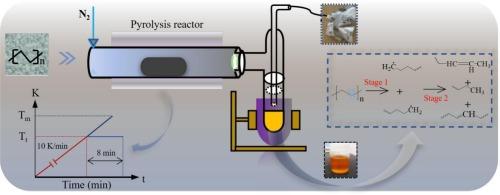Threshold temperature pyrolysis of waste plastic and the effect on pyrolysis energy consumption and product distribution
IF 5.4
3区 工程技术
Q2 ENERGY & FUELS
引用次数: 0
Abstract
Pyrolysis technology, as a key method of waste resource utilization, its pyrolysis efficiency directly affects the feasibility of circular economy. However, conventional pyrolysis processes often rely on higher pyrolysis temperatures, which not only increase energy consumption but also lead to a more complex distribution of pyrolysis products. Therefore, developing a pyrolysis process that is low in energy consumption and high in added value is particularly important. This paper uses polyethylene, the plastic with the largest global production, as the experimental material, and systematically analyzes the evolution of multidimensional parameters (pyrolysis characteristics, pyrolysis function models, apparent activation energy, and conversion rate) during its pyrolysis process. Based on the evolution of the multidimensional parameters, the “threshold temperature pyrolysis process” for polyethylene was developed, and its feasibility was verified through experiments and ANSYS Workbench simulation. The research results indicate that the threshold temperature pyrolysis process has a lower pyrolysis temperature and forms a stable thermal field distribution during the isothermal stage. This stable thermal field distribution not only reduced energy consumption by 6.1 % through regulating the reaction pathways of free radicals, but also increased the pyrolysis oil yield by 11.5 %. Furthermore, the lower pyrolysis temperature and stable thermal field distribution under the threshold temperature pyrolysis process regulate the migration of pyrolysis oil components towards lighter fractions by slowing down the reaction rate and extending the residence time of long-chain hydrocarbons. The above studies also provide quantifiable theoretical basis and methodological support for the high value utilization of other waste materials.

废塑料的阈值温度热解及其对热解能耗和产物分布的影响
热解技术作为垃圾资源化利用的关键手段,其热解效率直接影响循环经济的可行性。然而,传统的热解工艺往往依赖于较高的热解温度,这不仅增加了能耗,而且导致热解产物的分布更加复杂。因此,开发一种低能耗、高附加值的热解工艺就显得尤为重要。本文以全球产量最大的塑料聚乙烯为实验材料,系统分析了其热解过程中多维参数(热解特性、热解函数模型、表观活化能、转化率)的演变规律。基于多维参数的演化,提出了聚乙烯的“阈值温度热解工艺”,并通过实验和ANSYS Workbench仿真验证了其可行性。研究结果表明,阈温热解过程热解温度较低,在等温阶段形成稳定的热场分布。这种稳定的热场分布不仅通过调节自由基的反应途径降低了6.1%的能量消耗,而且使热解油收率提高了11.5%。此外,阈温热解过程中较低的热解温度和稳定的热场分布通过减缓反应速率和延长长链烃的停留时间来调节热解油组分向较轻馏分的迁移。上述研究也为其他废弃物的高价值利用提供了可量化的理论依据和方法支持。
本文章由计算机程序翻译,如有差异,请以英文原文为准。
求助全文
约1分钟内获得全文
求助全文
来源期刊

Thermal Science and Engineering Progress
Chemical Engineering-Fluid Flow and Transfer Processes
CiteScore
7.20
自引率
10.40%
发文量
327
审稿时长
41 days
期刊介绍:
Thermal Science and Engineering Progress (TSEP) publishes original, high-quality research articles that span activities ranging from fundamental scientific research and discussion of the more controversial thermodynamic theories, to developments in thermal engineering that are in many instances examples of the way scientists and engineers are addressing the challenges facing a growing population – smart cities and global warming – maximising thermodynamic efficiencies and minimising all heat losses. It is intended that these will be of current relevance and interest to industry, academia and other practitioners. It is evident that many specialised journals in thermal and, to some extent, in fluid disciplines tend to focus on topics that can be classified as fundamental in nature, or are ‘applied’ and near-market. Thermal Science and Engineering Progress will bridge the gap between these two areas, allowing authors to make an easy choice, should they or a journal editor feel that their papers are ‘out of scope’ when considering other journals. The range of topics covered by Thermal Science and Engineering Progress addresses the rapid rate of development being made in thermal transfer processes as they affect traditional fields, and important growth in the topical research areas of aerospace, thermal biological and medical systems, electronics and nano-technologies, renewable energy systems, food production (including agriculture), and the need to minimise man-made thermal impacts on climate change. Review articles on appropriate topics for TSEP are encouraged, although until TSEP is fully established, these will be limited in number. Before submitting such articles, please contact one of the Editors, or a member of the Editorial Advisory Board with an outline of your proposal and your expertise in the area of your review.
 求助内容:
求助内容: 应助结果提醒方式:
应助结果提醒方式:


